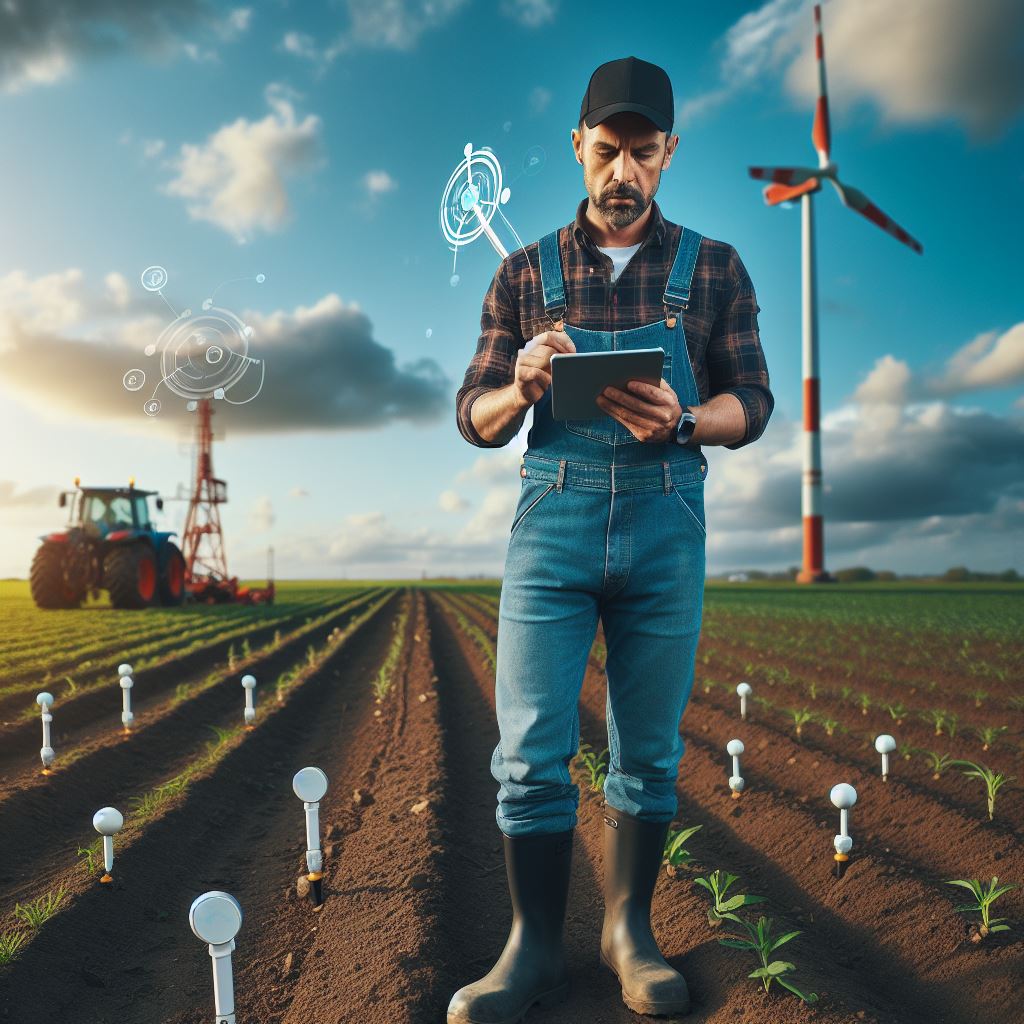Introduction
Let’s explore robotic farm hands: The new agri trend.
The agricultural industry plays a vital role in providing food for a growing global population.
To keep up with the increasing demand, farmers have been seeking new technological advancements.
One such innovation that has gained significant attention is the use of robotic farm hands.
They are automated systems designed to assist in various agricultural tasks.
These robots carry out activities such as planting seeds, harvesting crops, and even monitoring plant health.
They are equipped with advanced sensors and artificial intelligence, allowing them to perform their duties efficiently.
The emergence of robotic farm hands is driven by the need for increased productivity and efficiency in farming operations.
Traditional agricultural methods often face challenges such as labor shortages and rising labor costs. With the implementation of robotic farm hands, these limitations can be overcome.
They offer several benefits to the agricultural industry. They can operate 24/7, significantly reducing the time required for tasks like planting and harvesting.
Additionally, their precision and accuracy help optimize resource utilization, reducing wastage and increasing yields.
Moreover, these robots can improve worker safety by taking over hazardous tasks such as handling heavy machinery or applying pesticides.
With the ability to collect and analyze data, it provide valuable insights for farm management, enabling farmers to make informed decisions.
In short, theys are revolutionizing the agricultural industry by increasing productivity, efficiency, and worker safety.
As the global population continues to grow, it is imperative to embrace such advancements to meet the future demand for food.
Transform Your Agribusiness
Unlock your farm's potential with expert advice tailored to your needs. Get actionable steps that drive real results.
Get StartedThe integration of robotic farm hands marks a significant milestone in the evolution of agriculture, heralding a new era of sustainable and automated farming.
Evolution of Farming Techniques
Traditional farming methods
For centuries, agriculture relied on manual labor, with farmers performing all tasks by hand.
Traditional methods involved planting seeds, tilling the land, and harvesting crops manually.
Farmers relied on their physical strength and endurance to cultivate the land and produce yields.
Introduction of mechanization
The Industrial Revolution brought significant advancements with the introduction of mechanized farming.
Machines such as tractors, combine harvesters, and seed drills transformed the efficiency of agricultural practices.
Mechanization allowed farmers to cover larger areas, increase productivity, and reduce labor requirements.
Advantages and limitations of mechanization
- Mechanization improved the speed and accuracy of farm operations, enhancing productivity and reducing costs.
- It reduced the dependence on manual labor, allowing farmers to focus on strategic decision-making.
- However, mechanization also posed limitations due to its high initial costs, maintenance requirements, and limited adaptability to varying terrains.
Need for advanced farming technologies
As global demand for food continues to rise, the need for advanced farming technologies becomes crucial.
Robotic farm hands are emerging as a new trend in agriculture, offering increased efficiency and precision.
These advanced technologies address the limitations of mechanization and aim to revolutionize farming practices.
In fact, the evolution of farming techniques has transitioned from traditional methods to mechanization, and now to advanced technologies like robotic farm hands.
While traditional farming involved manual labor, mechanization improved productivity but had its limitations.
The need for advanced farming technologies arose due to increasing food demands.
They present a new trend in agriculture, promising increased efficiency and precision.
As technology continues to advance, the future of farming looks promising with the integration of robotics and automation.
Read: Drone Tech in Agriculture: A Game Changer
Robotic Farm Hands: Definition and Functionality
Definition of robotic farm hands
Robotic farm hands are automated machines designed to assist with various agricultural tasks.
Using advanced technology and sensors, these robots are capable of performing tasks traditionally done by human labor.
Introduction to their functions
Robotic farm hands have a wide range of functions, which contribute to increased efficiency and productivity in farming operations.
They can be programmed to do tasks such as planting seeds, harvesting crops, and applying fertilizers or pesticides.
Range of tasks performed by robotic farm hands
These intelligent machines can perform multiple tasks on the farm, including:
- Seeding: They can accurately plant seeds at the right depth and spacing, ensuring optimal crop growth.
- Crop monitoring: With sensors and cameras, they can monitor the health and growth of crops, identifying any signs of disease or nutrient deficiencies.
- Weed control: They use computer vision technology to detect and remove weeds without the need for harmful herbicides.
- Harvesting: They can efficiently harvest crops, ensuring minimal damage and maximizing yield.
- Soil analysis: By collecting data on soil composition and fertility, they help farmers make informed decisions regarding fertilization and irrigation.
Benefits of using robotic farm hands over traditional methods
The adoption of robotic farm hands offers several advantages over traditional farming methods:
- Increased efficiency: They can work around the clock, without breaks or fatigue, leading to higher productivity.
- Precision farming: These robots can perform tasks with exceptional accuracy, reducing wastage and maximizing yields.
- Cost-effective: Although initial investment may be high, they can save costs in the long run by reducing labor expenses and optimizing resource utilization.
- Improved safety: Farmers can significantly reduce the risk of injuries associated with manual labor, as robots take over physically demanding tasks.
- Environmental sustainability: By accurately applying fertilizers and pesticides only where needed, they help minimize their negative impact on the environment.
- Data-driven decision making: With their ability to collect and analyze data, they provide valuable insights to optimize farm operations and make informed decisions.
In essence, they are revolutionizing agriculture by automating various tasks traditionally performed by humans.
Their range of functions, from seeding to harvesting, offer increased efficiency, precision, and sustainability.
Showcase Your Farming Business
Publish your professional farming services profile on our blog for a one-time fee of $200 and reach a dedicated audience of farmers and agribusiness owners.
Publish Your ProfileFarmers who embrace this new trend can greatly benefit from higher productivity, cost savings, and safer work environments.
Read: The Rise of Smart Farming Technologies
Advancements in Robotic Farming Technologies
Robotics and automation have gained significant traction in the agriculture industry, with advancements in technology revolutionizing farming practices.
These technological developments have led to the emergence of robotic farm hands, which are poised to become the new agri-trend.
The integration of hardware advancements and software developments has paved the way for more efficient and productive farming operations.
Hardware advancements
Precision sensors
Precision sensors play a pivotal role in robotic farming by providing accurate data on soil conditions, crop health, and environmental factors.
These sensors enable farmers to make data-driven decisions on irrigation, fertilization, and crop protection, leading to optimized resource utilization and improved yields.
Robotic arms and grippers
Robotic arms equipped with specialized grippers are designed to handle delicate tasks such as harvesting fruits and vegetables.
These automated arms can mimic human-like movements, ensuring gentle handling of crops to minimize damage and enhance product quality.
Autonomous navigation
The ability of robotic farm hands to navigate autonomously is crucial for their practical implementation in large-scale farming operations.
Utilizing advanced machine vision systems, robots can identify obstacles, navigate complex terrains, and efficiently navigate through crops while performing tasks such as planting, weeding, and harvesting.
Software developments
Artificial intelligence and machine learning
The application of artificial intelligence (AI) and machine learning (ML) algorithms in robotic farming has ushered in new possibilities.
AI-powered robots can analyze vast amounts of data collected by sensors and make intelligent farming decisions, such as identifying and eliminating weeds or pests, predicting crop diseases, and optimizing irrigation schedules.
Data analysis and decision-making algorithms
Robotic farm hands generate an abundance of data during farming operations, ranging from soil moisture levels to crop growth patterns.
With sophisticated data analysis algorithms, this data can be processed and transformed into actionable insights, enabling farmers to make informed decisions in real-time.
These algorithms also contribute to the continuous learning and improvement of robotic farming systems over time.
The combined effect of hardware advancements and software developments in robotic farming has revolutionized agriculture.
They enhance productivity, minimize labor needs, and reduce the overall environmental impact of farming practices.
One of the key advantages of robotic farming is its potential to address the challenge of labor shortage in the agricultural sector.
With the adoption of robotic technology, farmers can overcome the difficulties in finding and retaining skilled labor, ensuring efficient and reliable operations throughout the year.
Moreover, they enable precise and optimized resource management.
By leveraging precision sensors, robots can tailor irrigation, fertilization, and pesticide usage to the specific needs of crops, minimizing waste and environmental pollution.
The integration of AI and ML algorithms in robotic farming systems also offers the potential for continuous improvement and optimization.
As robots gather more data over time, they can fine-tune their decision-making processes, leading to higher crop yields and more sustainable farming practices.
In general, advancements in robotic farming technologies have opened up new possibilities for the agriculture industry.
The integration of hardware advancements such as precision sensors, robotic arms, and autonomous navigation, along with software developments including AI and ML algorithms, has transformed traditional farming practices.
Robotic farm hands offer increased productivity, improved resource management, and sustainable farming solutions, making them the new agri-trend to watch out for.
Read: AI and Agri: The Future of Crop Management
Applications of Robotic Farm Hands
Robotic farm hands have revolutionized the agricultural industry, offering numerous benefits and transforming traditional farming practices.
These advanced machines are designed to perform a wide range of tasks efficiently and accurately, making them essential tools in modern agriculture.
Crop cultivation and harvesting
One major application of robotic farm hands is in crop cultivation and harvesting.
These robots are capable of planting and seeding crops with precision, ensuring proper spacing and optimal growth conditions.
By automating these tasks, farmers can save time and increase productivity, thereby maximizing their yields.
Additionally, robotic farm hands can handle irrigation and fertilization, ensuring that plants receive the right amount of water and nutrients.
This not only saves labor but also helps to optimize resource usage and ultimately improve crop quality.
When it’s time to harvest, robotic farm hands excel at collection and sorting.
They can identify ripe crops, pick them without damaging the plants, and sort them based on size, quality, and other predetermined criteria.
With their speed and accuracy, these robots significantly reduce the labor required for harvesting, allowing farmers to efficiently manage large-scale operations.
Livestock management
Livestock management is another area where robotic farm hands prove to be invaluable. These robots can automate tasks such as feeding and monitoring.
By accurately distributing feed, they ensure that each animal receives an adequate and balanced diet.
Showcase Your Farming Business
Publish your professional farming services profile on our blog for a one-time fee of $200 and reach a dedicated audience of farmers and agribusiness owners.
Publish Your ProfileMoreover, these robots can monitor livestock health and welfare, detecting signs of illness or distress.
They can assess vital parameters like body temperature and heart rate, allowing timely intervention and prevention of potential health issues.
This real-time monitoring not only improves animal welfare but also reduces the risk of disease outbreaks within herds.
Pest control and agricultural monitoring
In the realm of pest control and agricultural monitoring, robotic farm hands provide great assistance to farmers.
Equipped with advanced sensors and imaging systems, these robots can identify and eliminate harmful insects and weeds, reducing the need for chemical pesticides.
They can constantly monitor crop conditions, soil moisture levels, and other important agricultural factors.
By collecting and analyzing this data in real-time, farmers can make informed decisions, adjust their cultivation practices, and take proactive measures to prevent crop damage or yield loss.
In brief, the applications of robotic farm hands are vast and encompass various aspects of agriculture.
Crop cultivation and harvesting, livestock management, and pest control are just a few areas where these robots have made significant contributions.
As advancements in robotics and artificial intelligence continue, we can expect further innovations that will revolutionize and improve the agricultural industry even more.
Read: GPS in Farming: How It Revolutionizes Agriculture

Benefits and Challenges of Robotic Farm Hands
Benefits
Increased efficiency and productivity
Robotic farm hands bring numerous benefits to the agriculture industry.
Firstly, they significantly enhance efficiency and productivity in farming operations.
With their precise and consistent movements, robots can perform tasks at a faster rate than humans, leading to increased output and reduced bottlenecks.
Cost reduction and labor savings
Secondly, implementing robotic farm hands results in significant cost reduction and labor savings.
While initial investments may be required, the long-term benefits outweigh the expenses.
Robots can work tirelessly without breaks, reducing the need for human labor and associated costs.
Improved crop quality and yield
Thirdly, these advanced machines contribute to improved crop quality and yield.
Robotic farm hands perform tasks with unparalleled accuracy, ensuring that crops are handled delicately and precisely.
This precision leads to higher-quality produce and increased yield, optimizing overall farm profitability.
Challenges and Limitations
Initial investment costs
While there are numerous benefits, the adoption of robotic farm hands also comes with challenges and limitations that need to be addressed.
One such challenge is the upfront investment costs associated with purchasing and implementing robotic systems.
Farmers must carefully assess their financial capabilities and choose the most appropriate robotic solutions that align with their specific needs and budgets.
Need for specialized training
Another challenge lies in the need for specialized training. Farmers and agricultural workers must acquire new skills to operate and maintain these robotic systems effectively.
Manufacturers should provide comprehensive training programs to ensure that users are proficient in handling and troubleshooting these advanced agricultural technologies.
Potential job displacement concerns
Furthermore, the potential displacement of jobs is a concern that needs to be carefully managed.
With the introduction of robotic farm hands, some traditional agricultural roles may no longer be necessary.
It is crucial for governments, agencies, and farm owners to anticipate these changes and create support mechanisms such as retraining programs or alternative employment opportunities to mitigate any negative impacts.
In review, the implementation of robotic farm hands in the agriculture industry brings numerous benefits, including increased efficiency and productivity, cost reduction, labor savings, and improved crop quality and yield.
However, challenges such as high initial investment costs, specialized training requirements, and potential job displacement concerns need to be carefully considered and addressed.
By striking a balance between technological advancement and human workforce preservation, the agricultural sector can fully leverage the advantages of robotic farm hands while ensuring sustainable and inclusive growth.
Successful Implementation Examples
In this section, we will explore some case studies of farms that have successfully implemented robotic farm hands, along with the positive outcomes and lessons learned from these experiences.
We will also discuss the future prospects and expansion opportunities in this field.
Case Studies of Farms Utilizing Robotic Farm Hands
- XYZ Farm, located in rural Iowa, implemented robotic farm hands to assist with harvesting crops.
- ABC Farm in California integrated robotic farm hands into their dairy operations for automated milking.
- 123 Farm, a large-scale poultry farm in Texas, introduced robotic farm hands for poultry feeding and monitoring.
These case studies demonstrate the diverse applications of robotic farm hands across different types of farms and agricultural activities.
Positive Outcomes and Lessons Learned
- Increased efficiency: All farms observed significant improvements in productivity and reduced labor costs.
- Improved accuracy: The precision and consistency of robotic farm hands resulted in higher quality outputs.
- Enhanced safety: With fewer manual labor tasks, the risk of injuries to farm workers decreased.
- Skills and training: Farmers had to adapt to new technology, with additional training required to operate and maintain the robots.
- Cost considerations: Farms had to invest in the initial setup costs and ongoing maintenance of the robotic systems.
Through these experiences, farmers have learned valuable lessons about the importance of proper training and cost-effectiveness while implementing robotic farm hands.
Future Prospects and Expansion Opportunities
- Widespread adoption: The success stories of these farms have sparked interest among other farmers, leading to increased adoption.
- Customization and development: As the technology advances, robotic farm hands will become more tailored to specific farming needs.
- Integration with AI and IoT: Future prospects include the integration of artificial intelligence and the Internet of Things, enabling smarter and autonomous farming systems.
- Scope for expansion: Robotic farm hands offer opportunities for farms to expand their operations without significantly increasing labor costs.
- Sustainability benefits: These robots can also contribute to sustainable farming practices by optimizing resource usage and reducing waste.
The future looks promising for the continued expansion and development of robotic farm hands in agriculture, leading to increased efficiency, improved sustainability, and enhanced profitability.
In a nutshell, this section has presented insightful case studies of farms utilizing robotic farm hands, highlighting the positive outcomes, lessons learned, and future prospects in this emerging agricultural trend.
The successful implementation of robotic farm hands has revolutionized farming practices, paving the way for a more technologically advanced and sustainable agricultural sector.
Conclusion
Robotic farm hands have emerged as a revolutionary trend in agriculture, aiming to transform traditional farming practices.
These automated machines serve as an alternative to human labor, solving issues of labor shortage and increasing productivity.
Showcase Your Farming Business
Publish your professional farming services profile on our blog for a one-time fee of $200 and reach a dedicated audience of farmers and agribusiness owners.
Publish Your ProfileThe implementation of robotic farm hands brings significant benefits to the agricultural industry.
It improves efficiency, reduces costs, and minimizes the environmental impact of farming.
Furthermore, it enables farmers to monitor and manage their farms remotely, providing safer working conditions and increased accuracy in crop management.
In terms of future implications, the adoption of robotic technology in farming is expected to increase rapidly.
As technology advances, robotic farm hands will become more sophisticated, capable of performing complex tasks and adapting to diverse farming conditions.
This advancement will lead to increased crop yields and a more sustainable agricultural industry.
The emergence of robotic farm hands as a new agri trend marks a significant shift in the way we approach and perceive farming.
While some may fear the replacement of human labor, it is important to recognize that this technology complements human touch rather than replaces it.
By collaborating with it, farmers can achieve higher productivity and ultimately contribute to a more efficient and sustainable food production system.
Embracing this new trend is essential for the future of agriculture.




